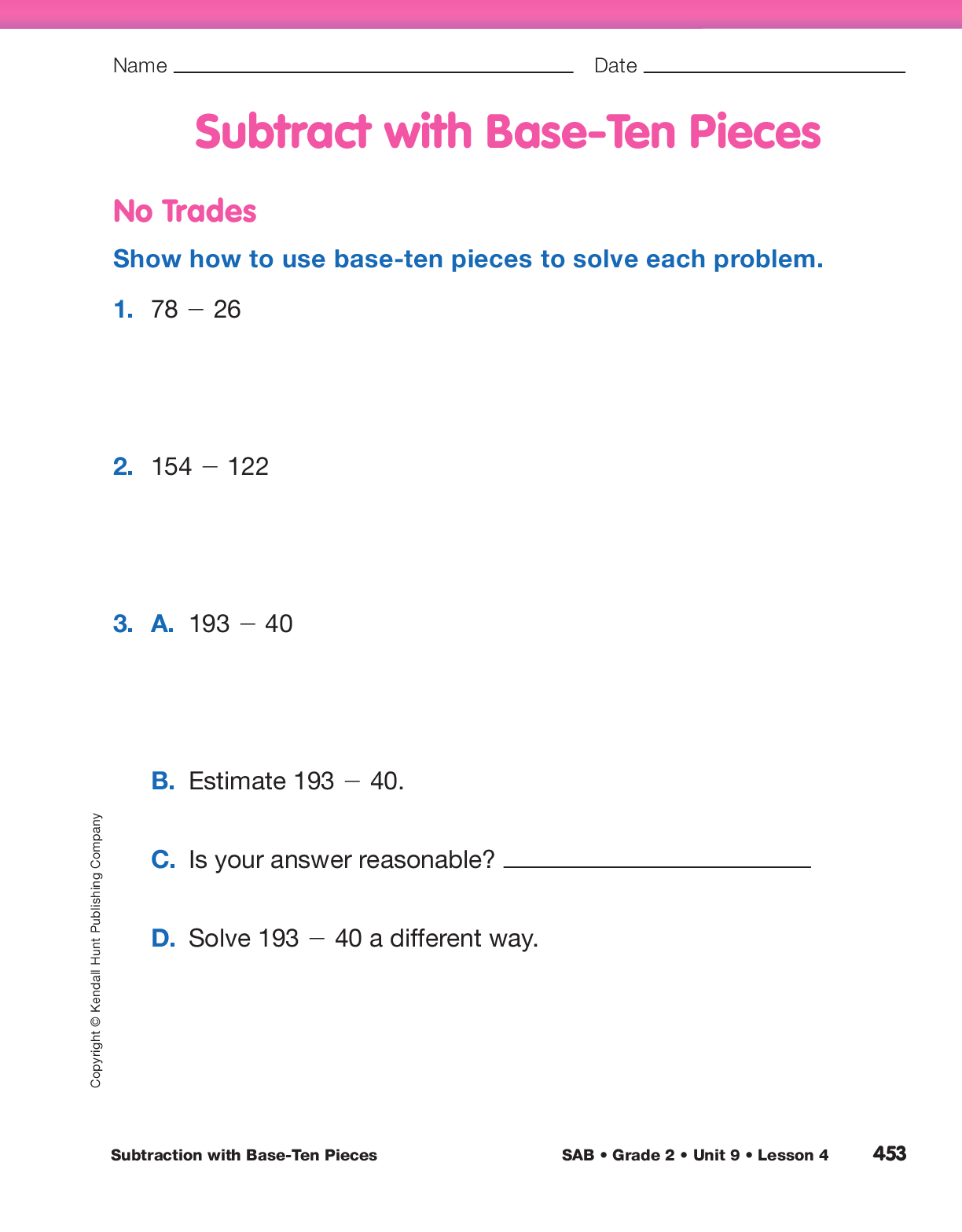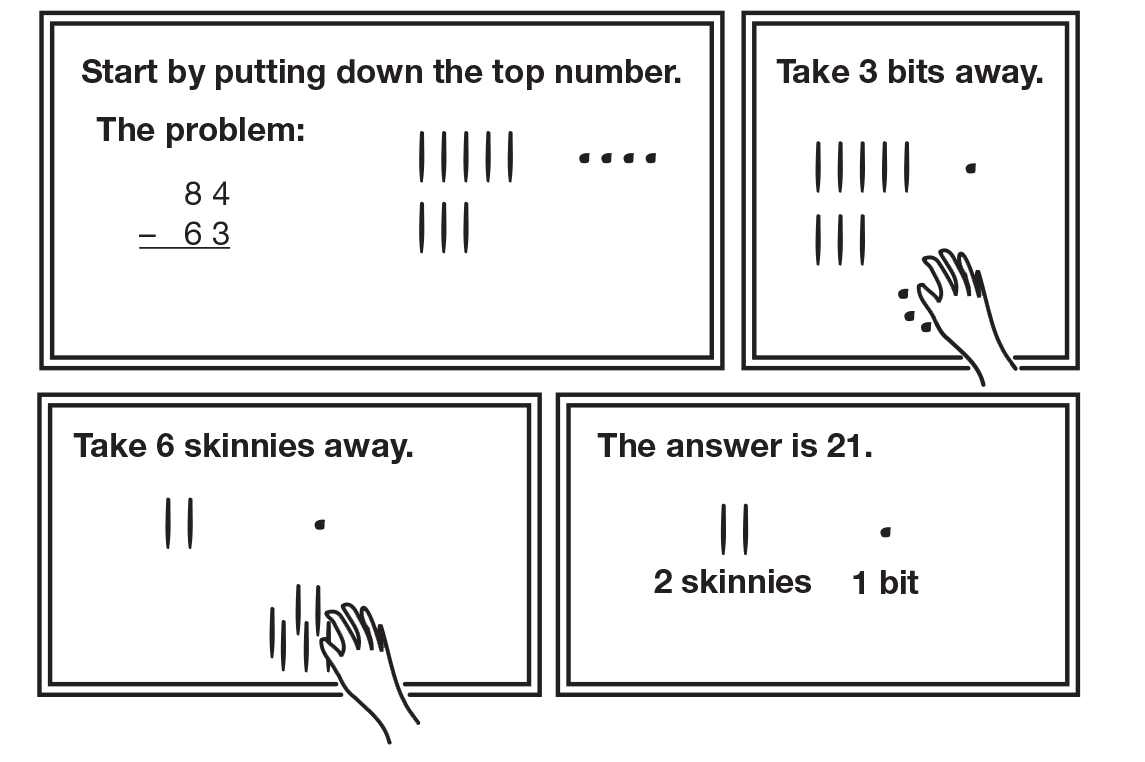Subtracting with Base-Ten Pieces. Before you start, be
aware that there is a fundamental difference between
modeling addition with base-ten pieces and modeling
subtraction. When modeling addition, you begin by putting
down pieces to represent each number you are adding (the
addends). But when modeling subtraction, you put down
only the pieces that represent the first number in the problem
(the minuend). You then show subtraction by taking away
pieces that represent the second number (the subtrahend).
See Figure 1. As students work with the problems, be sure
they do not begin the problem by laying out the pieces for
both numbers.
Estimate and Subtract with Base-Ten Pieces.
In this lesson, students solve several multidigit subtraction
problems with base-ten pieces. The purpose of
the activity is to help students develop a concrete
understanding of the trades involved in subtracting
as a foundation for their work with standard
paper-and-pencil algorithms. If you have enough
pieces, it is best if each student works with his or her
own set.
Begin by displaying the problem 84 − 63.
-
When you estimate, you can find out what a reasonable
answer might be. Show or tell how you
would estimate the difference to this problem. (Possible response: I think about friendly numbers for 84 and 63. 80 − 60 = 20.)
- Can someone explain a different way to estimate the difference? (Possible response: I think about a
number line. If I start at 63 and take 2 hops of 10, I land on 83, so the difference between the two numbers is about 20.)
Tell students to model the number 84 with base-ten
pieces using the Fewest Pieces Rule. See Figure 1
and the Content Note. Ask them to check with their
neighbor to make sure they have all represented 84 correctly.
-
What is the value of the 8 in 84? (80)
-
Which pieces represent the 8? (8 skinnies)
-
What pieces will you remove to represent taking away 63? (remove 6 skinnies and 3 bits)
-
Can you say that in tens and ones? (6 tens and
3 ones)
-
What pieces represent the 6 in 63? (6 skinnies)
- What number does the 6 stand for in 63? (60)
- After removing the 6 skinnies and 3 bits, what do you have left? (2 skinnies and 1 bit)
- What number is that? (21)
Fewest Pieces Rule. Students use the Fewest Pieces Rule to
make numbers using the fewest number of base-ten pieces.
For example, the number 43 can be represented with 43 bits,
3 skinnies and 13 bits, 2 skinnies and 23 bits, or 1 skinny
and 33 bits. After making all trades that are possible, 43 is
represented by 4 skinnies and 3 bits. Help students
understand that 4 in the number 43 represents 4 tens or
4 skinnies and the 3 represents 3 ones or 3 bits.
For the first few subtraction problems students solve, delay
mentioning the second number until it is time to subtract.
This will ensure that students do not put down pieces to
represent both numbers at the beginning of the problem. For
example, do not begin by saying, “We are going to solve
84 – 63.” Instead, say, “Please represent the number 84 with
base-ten pieces.” Then say, “Now take away pieces that
represent 63.” Ask, “What is our number sentence?”

When solving subtraction problems, students should manage
three piles of pieces—the “bank,” where they can go to trade
pieces or get new pieces; the “work pile” that first shows the
pieces they start with and then, after the problem is solved,
shows the answer; and the “take-away pile” that contains the
pieces they have taken away. They can push the take-away
pile to the side of their workspace. The “take-away pile”
allows students to check that they have, in fact, taken away
the correct amount. It can also be used to check their work
by adding. Students add their “take-away pile” to the pieces
in their answer to see if they get the minuend.
Give students a few other problems that do not
involve trades. For example:
| 42 |
168 |
257 |
| − 11 |
− 143 |
− 25 |
Use the following prompts for each problem. These prompts use 257 − 25 as an example.
- Explain how to estimate the difference so that you
will know if your answer is reasonable or not. (Possible response: I think about money. If I have
about $2.50 and I take away 25 cents or a quarter, I will still have a lot of money left. 250 − 25 = 225.)
- Represent the number [257] with base-ten pieces
using the Fewest Pieces Rule. (2 flats, 5 skinnies,
7 bits)
- Now take away the pieces that represent [25]. (remove 2 skinnies and 5 bits)
- What is the number sentence? (257 − 25 = 232)
- In your answer 232, which base-ten pieces represent 200? (2 flats)
- What do the 3 skinnies represent? (30 or 3 tens) And the 2 bits? (2 or 2 ones)
It is important to give students enough time to solve
subtraction with base-ten pieces. In doing so, they can
develop meaning for subtraction for themselves. Afterwards,
they can develop a connection between their work with
base-ten pieces and paper-and-pencil methods.
This sample dialog was taken from classroom video in which
a student solves 68 − 43.
Teacher: Who's ready? Marco, go ahead. It was
68 minus 43.
Marco: [represents the number 68 with 6 skinnies and
8 bits] 68.
Teacher: How did you make 68?
Marco: 6 skinnies.
Teacher: Uh-huh.
Marco: And that's 60 and 8 bits. That's 68.
Teacher: Very good.
Marco: Subtract—minus 43 [removes 4 skinnies and 3 bits].
Teacher: 43. How many skinnies are you taking?
Marco: 4 . And it equals 25.
Teacher: Can you count them for us, point to them and count
them?
Marco: 10, 20, [points to the 2 skinnies that are left] 21, 22,
23, 24, 25 [points to the remaining 5 bits].
Teacher: Very good.
Check Subtraction with Addition. After solving a
problem such as 257 − 25 with base-ten pieces, ask
students to put their “take-away pile” back together
with their answer pile.
- What number is shown by the pieces in your take-away pile? (25)
- What number is shown by the pieces in your answer pile? (232)
- What number is shown when you put the piles back together? (257)
- What is a number sentence that shows this?
(25 + 232 = 257)
- How does that connect to our subtraction problem?
(When we put the “take-away” pile together with the “answer” pile, we get the number we started with.)
As you discuss the problems with your students,
remember to periodically ask how a problem can be
solved in a different way. It is important that students
continue to practice and hone the other strategies
they have developed for subtraction and
develop the habit of checking their work.
Display the Subtraction Strategies Chart students
generated in Lesson 2 and encourage students to
refer to it as they work. Students might solve a problem
a second time using mental math strategies
(composing and decomposing numbers, counting
up), using number lines, a 200 Chart, or an invented
strategy from the chart. Remind students that when
they solve a problem a second way, they can check
to see if their answer makes sense, [MPE3, Check
for reasonableness] and then check their calculations
[MPE4, Check my calculations].
Have students use their base-ten pieces to solve
problems in the No Trades section of the Subtract
with Base-Ten Pieces page in the Student Activity Book. In Question 3, they estimate, record the
answer they get from working with the pieces, and then show a different way of solving the same problem.

















